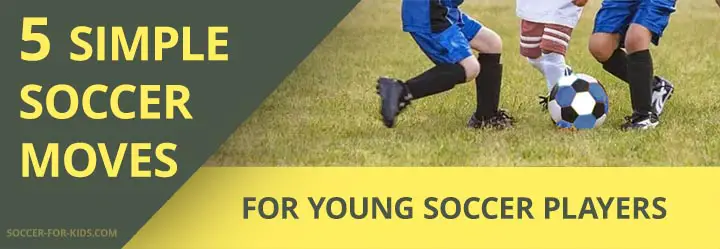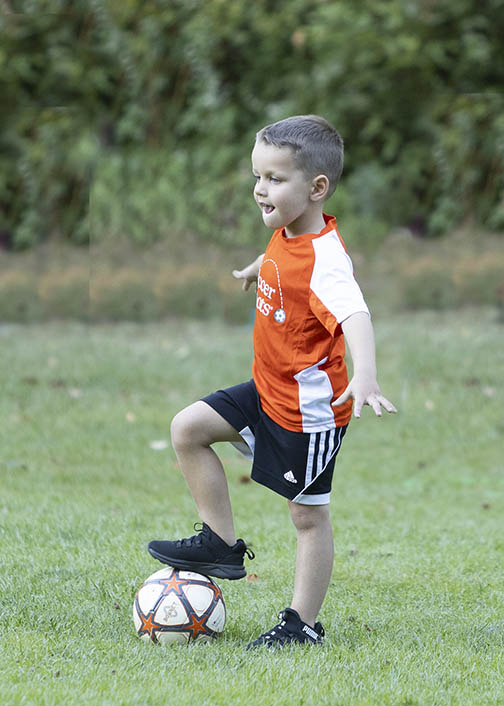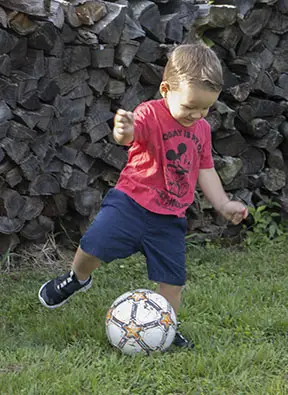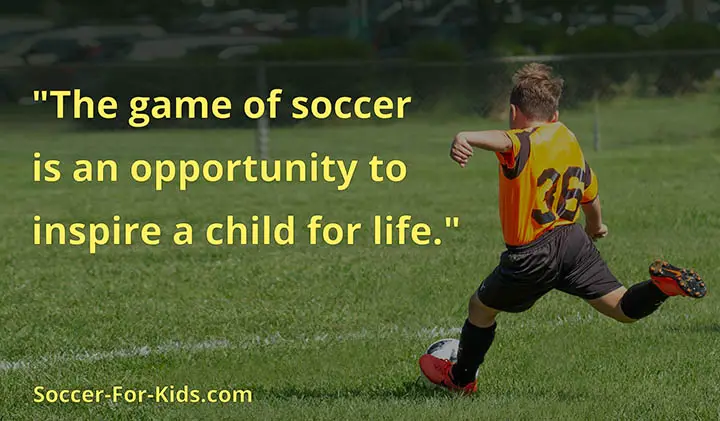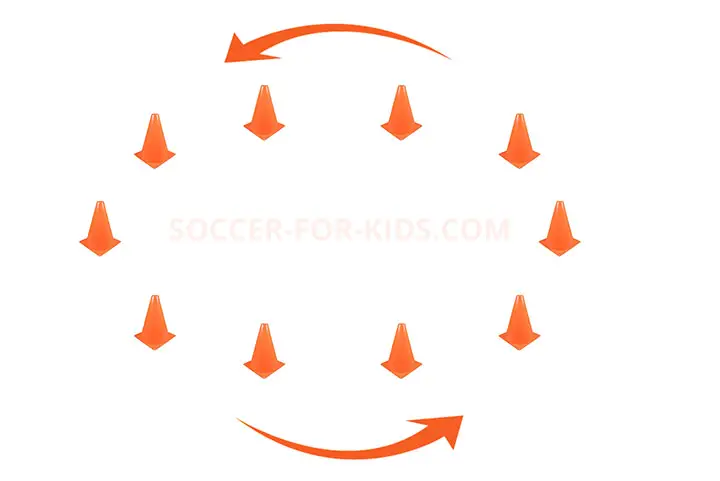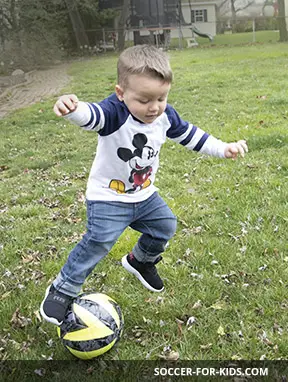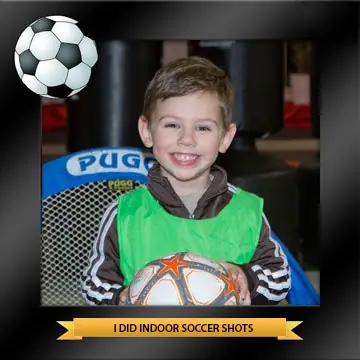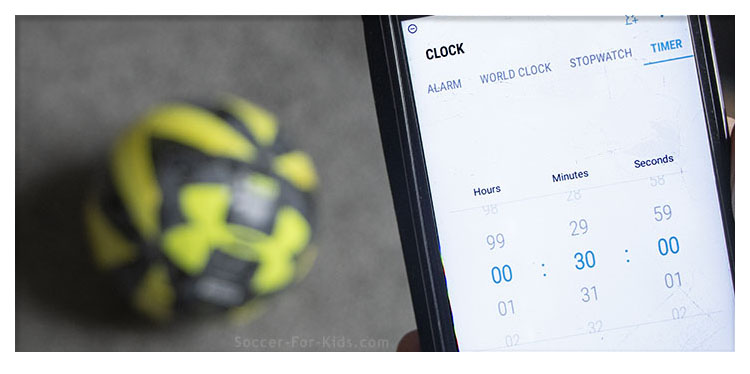5 simple soccer moves for kids
The Best moves to teach beginner soccer players first
What are some simple soccer moves you can teach young beginner soccer players? Whether you're just playing with your 2 year old in the back yard, or you want your 3 year old's team to learn a few useful foot skills, it's useful to know a few beginning soccer players moves that are easy to teach and easy to learn.
If you don't know what soccer moves you should teach first, you'll love these 5 simple soccer moves for kids. Here's the list of soccer moves that are super simple to teach to 2, 3, and 4 year old children.
- The Control Move. Also described as the control position. The very first skill to teach newbie soccer players.Switch Accounts
- Step Over Move. An easy way to change the their direction with the ball for young kids.
- Pull Back Move. The follow up skill that piggybacks on the control position.
- The Chop Move. Once learned this move is used extensively at all levels of soccer.
- The Outside Chop. A variation of the basic chop move that gives all players better versatility.
Now let's dive a little deeper into these moves and learn what's good for young players and also take a look at how to teach them.
1. The Control Move
What is the control move? It's simply gently placing the bottom of the foot onto the top of the ball.
The control move will become a starting position for other soccer moves in the future, so it's a great skill to start with.
The control move is a great first move for soccer players in the U5, U4, and U3 age groups. Children this age are just beginning to learn balance and the control move helps the kids develops those core muscles and improve their balance.
For the youngest soccer players they can make believe they are an airplane and can spread their arms out like airplane wings to help with maintaining balance.
How To Do The Control Move
Watch this video below of a 2 year old doing the control move followed buy a kick. As you'll hear you don't have to call it the "control" move or "control" position when you're describing it to such a young child. In this case this young soccer player was told to "squash the bug."
SOCCER CONTROL MOVE TIPS.
- Many kids struggle with keeping their balance at such a young age. Try having the children pretend that they are airplanes and extend their arms outward to the sides like airplane wings. That will help them maintain their balance.
- Secondly, make sure you show and tell them how to do the control move using their other foot as well. Just about everyone favors one leg or the other and it's important to develop skills, strength, and stamina with both legs.
- For brand new soccer players, start with the ball at rest when doing the control move. As the kids mature and can judge ball speed in relation to their dribbling speed, they'll be able to stop and control the ball while it's moving.
Soccer balls that are rolling toward the player can be "trapped" underneath the foot into the control position. Some coaches don't think the control position is an actual move, but I've found naming it as a move benefits the young kids by giving them confidence in progressing with other soccer moves.
Along with dribbling, shooting, and passing, the trapping of the soccer ball is one of the fundamental skills in soccer that lead to successful development.
2. The soccer step over move
The step over move is a basic building block that will lead to more advanced moves as your young soccer player develops. This kids soccer move is easily mastered by 2 year old and 3 year old soccer players.
STEP OVER MOVE TIPS:
- Like the control move, this soccer move is initially taught with the ball at rest and the foot on top.
- The second part of the move is just as important as the first. The children should immediately turn around so that the ball is in front of them again.
- Kick or dribble the ball in the opposite direction.
- Once the step over is mastered with the ball at rest, you can progress by trying it while dribbling slowly.
The step over move is a great way to keep the ball away from an opponent and a great way to change the direction of the ball. It become even more powerful when you learn how to step over the ball sideways in addition to stepping over it in a forward direction.
how to do the step over move
Here is a super short video showing you how to do the step over move. Like other moves and skills of soccer, the best way to teach it to a young player is to tell them. then show them. Then tell them and show them. See the video below.
3. the pull-Back move
The pull-back move is the next soccer move to teach your beginning player for several good reason. Initially, it's the first move for kids as young as two or three years old can do using the bottom of their foot. It's a natural progression from the first move we talked about, the control move.
Secondly, it's very beneficial for a young soccer player to have early success using a move which builds confidence in beginner players' minds to try their soccer moves during an actual soccer match.
Thirdly, the pull-back move can be used as a base for more intricate moves when newbie soccer players develop more foot skills down the road.
how to do the pull-back move
The pull back move starts just like the control move, with the bottom of the foot gently resting on top of the ball. This move is great for changing direction and keeping the soccer ball away from an opponent.
- Start with the ball at rest and begin with your foot on top of the ball.
- Roll the ball backward and lift your foot high enough to clear the ball.
- Turn 180 degrees so that the ball is in front of you. Dribble away.
As the kids advance in ability they'll be able to turn at the same time that they pull the ball backwards.
4. the chop move
The chop move is the third easiest soccer move for kids to learn. It can be used when the ball is at rest or can be used during dribbling.
The chop move is likely the most valuable move in youth soccer matches. It's also frequently used in soccer games for older kids and with more advanced levels as well.
It's a great move to keep the ball away from the defender and move it to areas of open space on the soccer field.
The youngest soccer players, ages 2, 3 and 4 year old kids will first try the chop move while standing still.
how to do the chop move
- It's best to introduce the youngest soccer players to the chop move with the ball in a stationary position.
- The ball is kicked at a sharp angle with the inside of the foot, coming in from the right of the ball.
- If they're kicking the ball with the right foot, the ball will be directed to the left.
As with other soccer moves and players of all age, it's a good idea to practice this with the naturally stronger leg as well as with the weaker leg. This is important when situations in the match present themselves where chopping should be done in a specific direction.
5. the outside chop move
The third move is a variation of the second, but is just as simple to teach to beginning soccer players that are learning basic soccer moves. This is a move that does NOT come as naturally as the inside chop move. It's best to wait until the "inside" chop move has been successfully learned before teaching the outside chop move.
how to do the outside chop move
- With the outside chop move the ball is chopped or cut to move at a sideways angle by using the outside area of the foot.
- Using the right foot to chop the ball, the ball will be kicked to the right.
- Start this skill with a stationary soccer ball. Then progress to teaching it while the kids are dribbling slowly.
The video below shows you how the chop move evolves as kids get older and perform the chop move at a higher speed.
soccer moves for young soccer players
These 5 basic soccer moves can easily be taught to toddlers and 2 or 3 years old children. These moves form a foundation that will serve as a building blocks for more advance levels of soccer as kids grow and develop. Here's a post on an additional soccer move that can be embarrassing if you are the defender and it's called the nutmeg.
For related articles see the links below my signature. For any youth soccer topic on this website use the search box below.


Soccer coach Bruce Lovelace started playing soccer in 1974 when, as a young boy, he constructed his own makeshift soccer goal. He played in high school, then in college and beyond. He started to coach his own children in the 1990s and then ran a Soccer Shots franchise for 12 years. Now, Coach Bruce publishes the soccer-for-kids.com website. Find out more about youth soccer coach Bruce Lovelace and what inspires this website.
Soccer-for-kids.com is a participant in the Amazon Services LLC Associates Program, an affiliate advertising program designed to provide a means for sites to earn advertising fees by advertising and linking to Amazon.com
